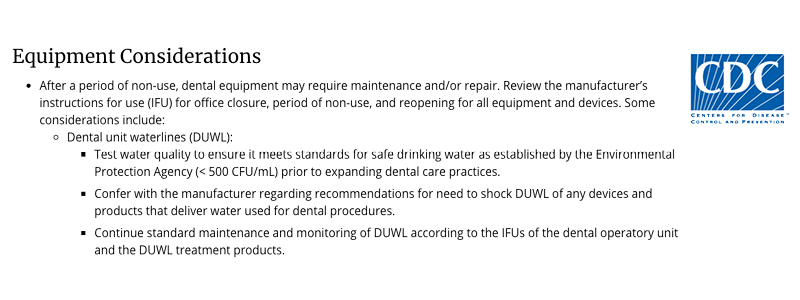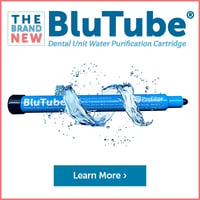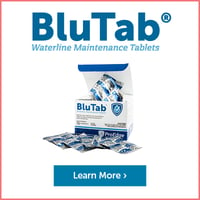While March seems like a different lifetime, the impact of COVID-19 dental office shutdowns remains heavy on our day-to-day work in the dental industry. And though many of us have adapted to some new state of "normal", infection prevention in dentistry is not the same.
 At the time, you and your team were swirling in a mad rush of concern for your families, your work, and the future. Shutting down may not have been the easy choice, but government mandates were... mandates.
At the time, you and your team were swirling in a mad rush of concern for your families, your work, and the future. Shutting down may not have been the easy choice, but government mandates were... mandates.
Thru March, April, and May, most dental practices were closed or limited to emergency care.
And all during that time, water and moisture sat stagnant inside the dental unit waterlines (even if your office purged the lines before shutdown, purging does not remove all water and biofilm still grows, albeit at a slower rate). That stagnation created the perfect environment for bacteria to spread and biofilm to form.
That's why dental unit waterlines need attention before returning to routine care – contamination is likely at an all-time high in dental. This can lead to waterlines with pathogenic bacteria like mycobacterium abscessus, Legionella, and Pseudomonas attaching, spreading, and then breaking off and flowing into patients' mouths.
Even before COVID19, 31% of treated waterline failed to meet the Centers for Disease Control (CDC) guideline for safe water (≤500 CFU/mL). And those dental unit waterlines had active antimicrobial running through and constant fresh water from municipal sources, but biofilm still led to contamination levels averaging over 32,000 CFU/mL.
So What Needs to Be Done?
As mandates lifted and practices begin to plan their reopen, the CDC recommended three actions for dental practices to secure their dental unit waterlines:
The CDC also recommended flushing your premise plumbing (sinks, toilets, showers, eye-wash stations) as building water systems were also likely contaminated for the same reason – stagnation. This is where legionella contamination from source water becomes a bigger concern.
Dental Waterlines Require Attention after COVID19 Shutdowns
with Mike Rust & Shannon Mills, DDS
So, before returning to routine care – or as soon as possible if you've already reopened! – shock your dental waterlines, test to make sure it meets the ≤500 CFU/mL standard, and then continue your routine treatment protocol.
If this sounds familiar, it might be! These CDC recommendations align with ProEdge's proven dental waterline protocol – The 3 Steps to Safe Water.
Step 1: Shock First
Shocking your dental unit waterlines is the process of using a strong disinfectant to completely clean the insides of your lines. To be truly effective, a shock protocol needs to both kill bacteria and remove it. After analyzing hundreds of thousands of real-world clinical test results, we've found two solutions that do that most consistently – a diluted bleach solution and a product made by Crosstex® called Liquid Ultra™.
Shocking does require independent water reservoirs or water bottle systems. If your dental unit does not have water bottles, don't hate the messenger! We truly wish there was a way, but there is reasonable way to shock your waterlines without water bottle systems. All dental units can be retrofitted by your favorite service technician.
Regardless of COVID19 reopening, the Team @ ProEdge recommends retrofitting as shocking is vital to any effective waterline maintenance protocol. Municipal cartridges and centralized systems do not consistently provide CDC-compliant waterlines without an effective shock protocol included.
Learn more about shocking at ProEdgeDental.com/shock.
Step 2: Treat Continuously
Specifically, this is the third step for COVID19 reopening as recommended by the CDC. But for normal routine care, this is step 2.
Treat your waterlines continually. This means adding a low-level antimicrobial (like a tablet or straw) to inhibit biofilm attachment and growth. Treating with a tablet or straw allows you to go quarterly or longer between shock treatments (otherwise, shocking needs to be done every week).
Step 3: TeST QUARTERLY
As the ADA has long stated, testing your dental waterlines is the only way to know if the water coming out of your dental unit is actually safe.
Unfortunately, our lab sees dental unit waterline contamination every day – sometimes because a treatment isn't strong enough; sometimes source water is poor and bacteria overwhelms the treatment; and other times there's a hidden equipment issue causing bacteria to easily redevelop.
Regardless, testing is the only way to know and it's the only way to document your practices CDC-compliance. With 33 state dental boards requiring CDC compliance, and some states adopting specific waterline testing legislation, your practice wants to be on top of this.
COVID19 may have created the perfect storm for dental unit waterline contamination, but it doesn't have to rule your world.
Follow the three steps and know that you've got a partner in waterline maintenance, because you didn't get into dentistry to clean waterlines, but we did. The Team @ ProEdge is available for complimentary consultations to help your practice get started.
DOWNLOAD THE 3 Steps to SAFE WATER PROTOCOL HERE:












